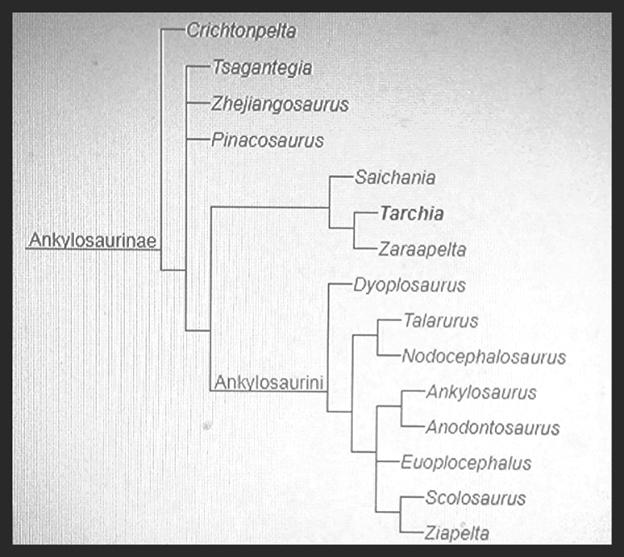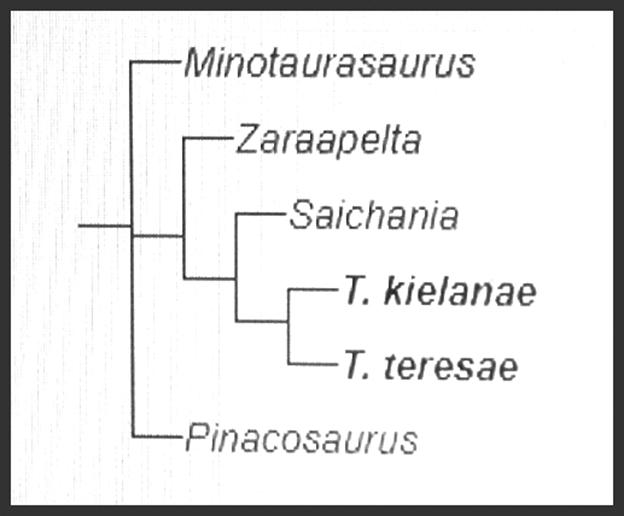Tarchia is currently, with Saichania, among the geologically youngest known of all the Asian ankylosaurid dinosaurs.
In 1977, Tatyana Tumanova named a second species: Tarchiagigantea. This was a renaming of DyoplosaurusgiganteusMaleev 1956, which had been based on specimen PIN 551/29.[2] In 1987, Tumanova concluded that both species were identical. This would make Dyoplosaurusgiganteus the senior synonym of Tarchiakielanae.[3] This was generally accepted and Tarchiagigantea became the usual species name, as a combinatio nova replacing Tarchiakielanae. However, recent study by Victoria Megan Arbour indicates that D. giganteus is indistinguishable from other ankylosaurs from the late Campanian-Maastrichtian of Mongolia, and hence a nomendubium; the study revived the name Tarchiakielanae.[4] A rump with tail and club, specimen ZPAL MgD I/113, once referred to Dyoplosaurusgiganteus and subsequently to Tarchiagigantea, was by Arbour seen as different from the D. giganteus holotype.[5]
The study by Arbour also concluded that specimen PIN 3142/250, in 1977 referred to Tarchia by Tumanova, probably belonged to Saichania instead. This would radically change the common image of Tarchia as this exemplar had been by far the best preserved and most illustrations, museum mounts and indeed scientific research had been based on it. Arbour discovered that the holotype of Tarchia shared distinguishing traits with that of Minotaurasaurus Miles & Miles 2009, concluding that the latter is a junior synonym of Tarchia.[6]
Subsequently, in 2016, a study conducted by Penkalski&Tumanova indicated that PIN 3142/250 is not referable to Saichania due to significant anatomical differences, but instead represents a new species of Tarchia, T. teresae. ThestudyalsorecognizedMinotaurasaurusas a distinctgenus.[7]
Description
Size estimates of Tarchia have been largely based on Dyoplosaurusgiganteus, the holotype of which is one of the largest ankylosaurian individuals known. This would make Tarchia the longest known Asian ankylosaur, with an estimated body length of 8 metres (26 ft).[8] Confusingly, the skull size often mentioned, with a length of 40 centimetres (16 in) and width of 45 centimetres (18 in), was again based on specimen PIN 3142/250, a much smaller individual. The holotypes of Tarchiakielanae and Minotaurasaurus also indicate a medium size. In 2010, Gregory S. Paul had estimated a body length of 4.5 metres and a weight of 1.5 tonnes.[9]
As an ankylosaurid, Tarchia would have had a broad, low-slung body, positioned on strong short legs. The body would have been protected by skin ossifications, named osteoderms. It probably had a bony tail club, for active defence against predators.
Tarchia had previously been distinguished from Saichania on the basis of its relatively larger basicranium, an unfused paroccipital process-quadrate contact and, based on PIN 3142/250, the fact that the premaxillary rostrum is wider than the maximum distance between the tooth rows in the maxillaries. In 2014, Arbour established two distinguishing traits apart from those known exclusively from the holotype of Minotaurasaurus; the back of the head is visible in top view; and deep groove runs along the front and outer side of the squamosal horn, and at the front it surrounds around an accessory osteoderm placed on the rear supraorbital, forming a deep furrow.[4]
The 2016 redescription of Tarchia notes that it differs from Saichania in having a postorbital fossa (which separates the squamosal horn from the supraorbital) and an accessory osteoderm; the occiput being visible in dorsal view; the large, deep braincase; the foramen magnum being higher than it is wide; and the nuchal osteoderms being taller laterally than medially. In addition, it differs from both Saichania and Minotaurasaurus in that it lacks postocularcaputegulae (or small, polygonal bony plates behind the orbit) and has a proportionally high occiput in caudal view.[7] The study additionally found that PIN 3142/250 (i.e. T. teresae) can be distinguished from T. kielanae in that the accessory osteoderm is not fused to the roof of the skull, the quadrate and paroccipital process are not fused, the back of the skull roof is strongly sculptured, and the openings for the fourth to twelfth cranial nerves is bifurcated.[7]
Much information given about Tarchia in older work refers to PIN 3142/250 (which was generally referred to Saichania until it was named as T. teresae in 2016). In 2001, it was stated that, in Tarchia, wear facets indicative of tooth-to-tooth occlusion are present;[10] this likely does not refer to the holotype specimen, since in the holotype no teeth are preserved.
Phylogeny
Vickaryous et alii in 2004 stated that Tarchia was basal to two distinct clades of Late Cretaceous ankylosaurids: one comprising North American taxa (Ankylosaurus, Euoplocephalus) and the other comprising Asian taxa (Pinacosaurus spp., Saichania, Tianzhenosaurus, Talarurus).[11] However, this was again based on PIN 3142/250, the characters of which usually defined the operational taxonomic unit named Tarchia in the various cladistic analyses. Remarkably, Tarchia and Saichania nevertheless in these analyses often occupied very different positions.
The following cladogram is based on a 2015 phylogenetic analysis of the Ankylosaurinae conducted by Arbour and Currie:[12]

A limited phylogenetic analysis conducted in the 2016 redescription of Tarchia, focusing on the interrelationships between Tarchia, Saichania, and Minotaurasaurus, is reproduced below.[7]

Palaeobiology
The rocks in which Tarchia fossils were found likely represent eolian dunes and interdune environments, with small intermittent lakes and seasonal streams. Hence, we know that Tarchia was a desert animal. On the other hand, well-watered forest would have been present. TarchiawouldhavebeenpreyeduponbyTarbosaurus.[9]
